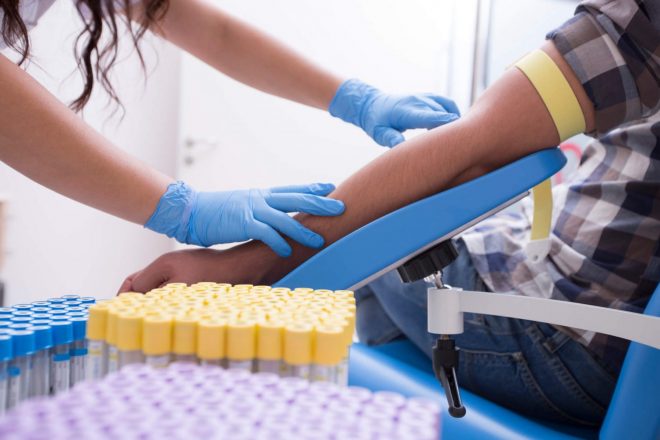

Need extra cash, but don’t know where to start? Your body is literally a cash making machine! Did you know that you can get paid to donate plasma?
I couldn’t believe I was standing in a blood plasma donation facility, getting ready to be hooked up — literally — to a giant whirring machine. I’m terrified of needles.
I found out that my veins were too small to take the large-bore needles they use in the donation process. I left the facility that day feeling partially relieved and partially peeved that I wasn’t eligible to go through with it.
I’d been looking for ways to make some extra money, and the facility would have paid me $40 per visit for my plasma if I went in eight times that month. That $320 sum would have taken a big chunk out of my student loan debt.
I’m not alone, either. There are hundreds of plasma collection centers across the United States, many of them located near college campuses filled with cash-strapped students. These facilities can be a great way to make some extra money. But there are a few things you should know before you start getting paid to donate plasma.
How Does Plasma Donation Work?
Plasma is the liquid in your blood that contains all sorts of molecules to keep you alive, such as antibodies and blood clotting agents.
For thousands of people with rare immune or blood-clotting diseases, plasma-related treatments literally mean the difference between life and death.
In order to be a qualified donor, you must be an adult who weighs at least 110 pounds; pass a brief physical exam (complete with finger sticks); follow a diet that includes between 50 and 80 grams of protein; pass a medical history screening; and — of course — have large-enough veins.
You must inform the medical staff if you’ve recently gotten tattoos or had surgeries, or if you are taking medication. It is also important to remain hydrated before and after the donation process.
Plasma collection facilities exist all over the United States, but make sure to do your research and check reviews before you go. When dealing with large needles, you certainly want to take care to ensure as comfortable an experience as possible.
After you arrive at the facility, your first appointment will likely take a couple of hours to get all the initial processing done. After that, each appointment should take about 90 minutes.
The donation itself is a relatively straightforward process. A needle is placed in your arm. A machine draws your blood, skims off some of the plasma, adds saline to the already-drawn blood to replace the lost fluid, and then returns it back to your body through the needle.
The entire process results in a small bottle of straw-colored plasma, which the collection facility then buys from you. Plasma collection facilities will generally let you donate twice weekly.
How Much Will I Be Paid to Donate Plasma?
Different companies offer different compensation rates that are often confusing. For example, many companies offer bonuses for your first month, or if you complete a certain number of donations per month. They’ll also generally pay you with a debit card, and those often come with various fees. So before you go in, be sure that you understand how the company will pay you.
CSL Plasma offers up to $700 per month of donations. And another one, BioLife, offers between $20 and $50 per donation. Plus, you may want to scout out the local college student newspaper to check for offers that will pay you more for each donation.
Side Effects of Plasma Donation
Plasma donation is a very safe process, but there’s still a risk of side effects. The most noticeable short-term effects are bruising, faintness, and dehydration, according to Medical News Today. Some people could even experience an allergic reaction to some of the substances used in the procedures. Thankfully, there is a well-trained medical staff nearby in case of an emergency.
Long-term effects of plasma donation are not too severe, even if you donate often. You can end up with scarring on your arm from the needles, which may be difficult to explain to friends and family.
Donating plasma is not without risks, and you should consider them carefully before making the decision to donate.
How Has COVID-19 Impacted Plasma Donation?
In the midst of the COVID-19 pandemic, it is important to keep in mind that medical facilities will be facing many challenges that they may not have experienced before. Social distancing will be chief among them, but methods will vary depending on individual donation facilities.
Unfortunately, plasma donations have been significantly impacted by the pandemic.
“From temperature readings to the stigma of being in hospitals, individual plasma donations have seen a substantial decline in recent months,” says Konstantinos Tsilkos, M.D., CEO of PharMed.
Unfortunately, it is more now important than ever that plasma donations continue. One potential COVID treatment involves the use of plasma taken from individuals who have tested positive for coronavirus and have experienced at least 14 days without symptoms, according to the U.S. Food and Drug Administration.
At the moment, this plasma is being sought out for investigative purposes only, but there is a potential for this to be a lifesaving treatment for those most affected by the disease.
The Bottom Line
If you are looking for a great way to earn some extra income during the pandemic, plasma donations could be the perfect solution. Not only will it take under two hours out of your day, but it could also save lives and help medical professionals in the fight against COVID-19.













